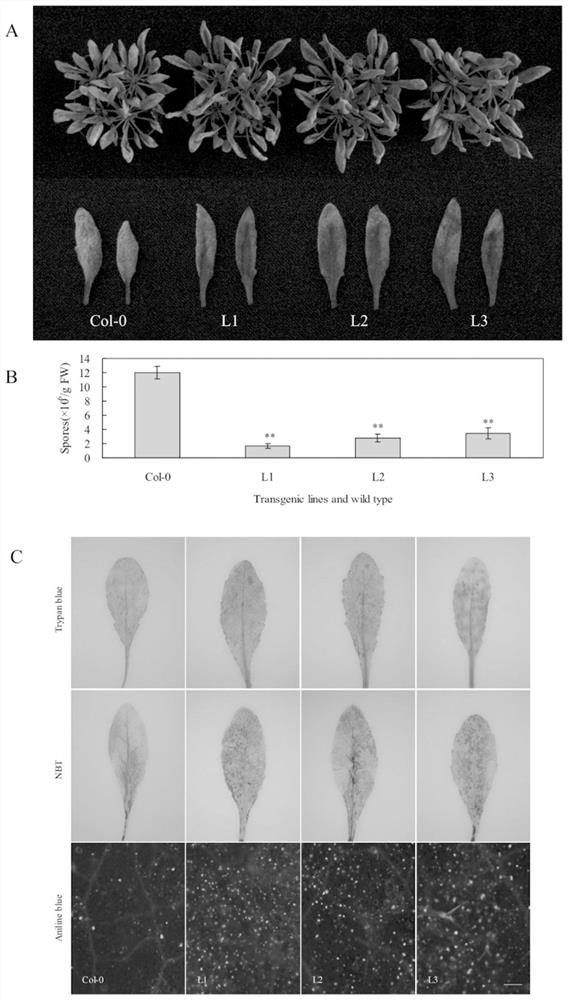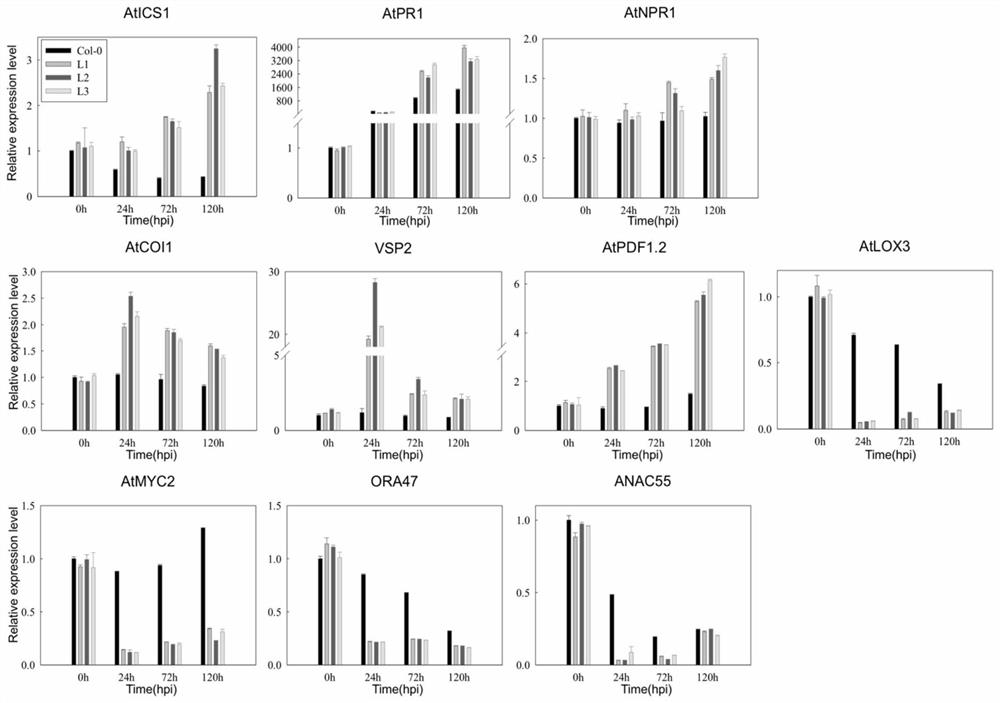Disease resistance gene vqjaz4 of wild hair grape merchant-24 and its application
A disease-resistance gene, the technology of hairy grapes, applied in the fields of application, genetic engineering, plant genetic improvement, etc., can solve the problem of less research on grape JAZ gene, improve the ability to resist powdery mildew, enhance plant immune response, and improve resistance Effect
- Summary
- Abstract
- Description
- Claims
- Application Information
AI Technical Summary
Problems solved by technology
Method used
Image
Examples
Embodiment 1
[0027] Example 1: Response to powdery mildew after transient transformation of grape leaves with VqJAZ4 promoter
[0028] In previous studies, we found that VqJAZ4 was induced by V. vinifera. In order to further verify this result, we cloned the promoter region of the VqJAZ4 gene and fused it in front of the GUS reporter gene to construct multiple transient expression vectors with different degrees of deletion ( figure 1 ), and transiently transformed into young grape leaves by vacuum pump, the different activities of promoter fragments with different length sequences were analyzed, and the activity changes of transiently transformed grape leaves after being inoculated with powdery mildew were analyzed. It is obvious from the figure that when no pathogen was inoculated, the activity of GUS staining from strong to weak was pVqJAZ4, D1 and D2. After inoculation of grape powdery mildew pathogen, the activity of GUS staining was generally enhanced, especially the activity of pVqJAZ...
Embodiment 2
[0029] Example 2: Response of wild hair grape merchant-24 disease resistance gene T3 generation VqJAZ4 transgenic Arabidopsis to powdery mildew
[0030] To verify the role of VqJAZ4 in plant defense, three T3 transgenic lines (L1, L2 and L3) and Arabidopsis thaliana Col-0 were inoculated against Arabidopsis thaliana powdery mildew to observe their responses to the pathogen . The inventor inoculated the 4-week-old adult seedlings with powdery mildew, observed the accumulation levels of dead cells, reactive oxygen species and callose in the Arabidopsis strain, counted the number of conidia of powdery mildew, and quantitatively analyzed the relative relative genes of disease resistance. Express the situation. The results showed that the disease state of the three transgenic lines was lighter than that of the wild control (Col-0) after inoculation with powdery mildew ( figure 2 ). The three transgenic lines showed strong powdery mildew-induced cell death, and the level of reac...
Embodiment 3
[0033] Example 3: Response of wild hair grape merchant-24 disease resistance gene T3 generation VqJAZ4 transgenic Arabidopsis to Botrytis cinerea
[0034] To verify the role of VqJAZ4 in plant defense, three T3 transgenic lines (L1, L2, and L3) and Arabidopsis thaliana Col-0 were inoculated against Arabidopsis botrytis, respectively, and their effects on the pathogen were observed. response. The inventors inoculated live adult seedlings grown for 4 weeks with Botrytis cinerea, observed the accumulation levels of dead cells and active oxygen in Arabidopsis strains, and counted the lesion area induced by Botrytis cinerea after inoculation, and quantitatively analyzed the disease resistance correlation. The relative expression of genes. The results showed that the disease status of the three transgenic lines after inoculation with Botrytis cinerea was heavier than that of the wild control (Col-0) ( Figure 4 ). Three transgenic lines showed strong botrytis-induced cell death, ...
PUM
 Login to View More
Login to View More Abstract
Description
Claims
Application Information
 Login to View More
Login to View More - R&D
- Intellectual Property
- Life Sciences
- Materials
- Tech Scout
- Unparalleled Data Quality
- Higher Quality Content
- 60% Fewer Hallucinations
Browse by: Latest US Patents, China's latest patents, Technical Efficacy Thesaurus, Application Domain, Technology Topic, Popular Technical Reports.
© 2025 PatSnap. All rights reserved.Legal|Privacy policy|Modern Slavery Act Transparency Statement|Sitemap|About US| Contact US: help@patsnap.com



